Climate-Resilient Coffee
Air Date: Week of July 18, 2025

Komal Sable says the excelsa coffee plant is more climate resilient than the arabica and robusta species. (Photo: South India Coffee Company)
Research has long shown that the top two coffee species, Arabica and Robusta, are vulnerable to climate impacts like increased drought and heat. And by 2050 as much as half of coffee producing land could no longer be suitable for these top species. But Living on Earth’s Sophia Pandelidis reports that excitement is brewing over a climate resilient bean called excelsa.
Transcript
[FOLGERS AD]
HUSBAND: Hey, great coffee.
WIFE: It’s instant Folgers. Doesn’t it taste good as fresh perked?
HUSBAND: Better.
WIFE: Better than those girls make at the office?
HUSBAND: Honey, their coffee can’t hold a candle to yours.
O’NEILL: Well, times sure have changed in a lot of ways since the ‘60s, but consumers are still as coffee obsessed as ever. Today the world produces over 24 billion pounds of coffee beans a year and that number is growing. Research has long shown that the top two species, Arabica and Robusta, which make up 99% of the market, are vulnerable to climate impacts like increased drought and heat. And by 2050 as much as half of coffee producing land could no longer be suitable for these top species. But there’s a glimmer of hope for coffee addicts and the farmers who depend on growing coffee for their livelihoods. Living on Earth’s Sophia Pandelidis reports that excitement is brewing over a climate resilient bean called excelsa.
SABLE: To tell you the truth, we've always had excelsa on our farms in India, and the farm that we live on, we've had excelsa on our farm for almost a couple of decades.
PANDELIDIS: Komal Sable runs a fifth generation, 70-acre coffee farm in Coorg, India with her husband, Akshay Dashrath. The farm is nestled in the foothills of the Western Ghats mountains, and Komal says at harvest time, the air there is fragrant with the sweet scent of ripening coffee fruit that holds the beans inside. The duo heads the South India Coffee Company, which sources specialty beans from local Indian farms and distributes them worldwide. Excelsa plants produce beans that can be processed into coffee like Arabica and Robusta. But Komal says excelsa has flown under the radar on most Indian farms, where it’s typically planted to mark borders and stock the family pantry.
SABLE: You know, it was always there at home. And my husband grew up drinking it as well. It was one of those things where we didn't know what to do with it.
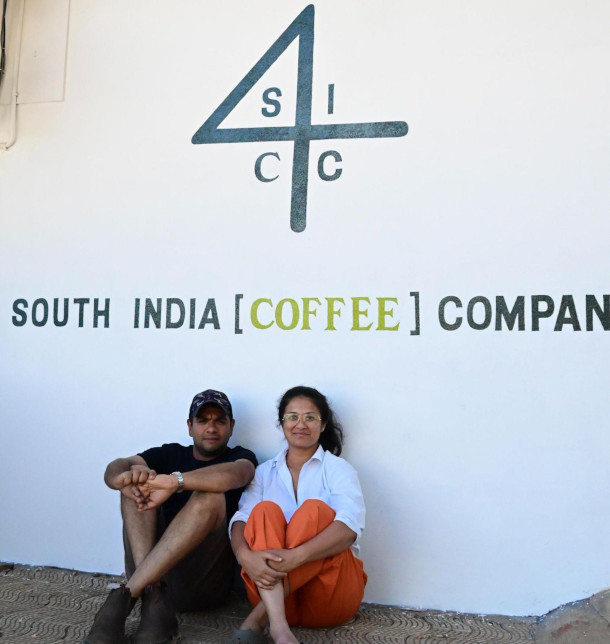
Komal Sable (right) and Akshay Dashrath (left) run the South India Coffee Company in Coorg, India. (Photo: South India Coffee Company)
PANDELIDIS: Excelsa has suffered from coffee wilt disease at times, perhaps making some farmers skeptical of its commercial value. But now climate change is pushing Komal and her team to see this plant in a new light. They noticed that extreme events like heavy rain and drought had little effect on excelsa.
SABLE: We always found that even if the Arabica suffered or the Robusta suffered due to climate change, excelsa was something that would always give us a medium crop without any intervention.
PANDELIDIS: Komal says excelsa is built to withstand climate shocks.
SABLE: They are extremely strong plants.
PANDELIDIS: Deep roots and large, thick leaves increase its ability to access and retain moisture. Those features make the coffee species a prime candidate for climate resiliency. Excelsa plants resemble trees, and tend to be larger than shrub-like Arabica and Robusta, reaching heights of up to 40 feet. Komal says that can make harvesting more labor-intensive, depending on how tall farmers let them grow. But that size has an upside. Bigger plants need more space, leaving room for other crops to grow among them and take advantage of the shade they provide.
SABLE: On our farm, we'll have figs, we'll have jackfruit, we'll have pepper. It's not just coffee.
PANDELIDIS: Komal says agroforestry, where a variety of crops are planted together with trees, is a system used traditionally in India that should be celebrated.
SABLE: It keeps the diversity alive. You have a lot of flora, fauna. You have indigenous species, you have birds that are there. You have this entire ecological system working around it, and it's not a monoculture.
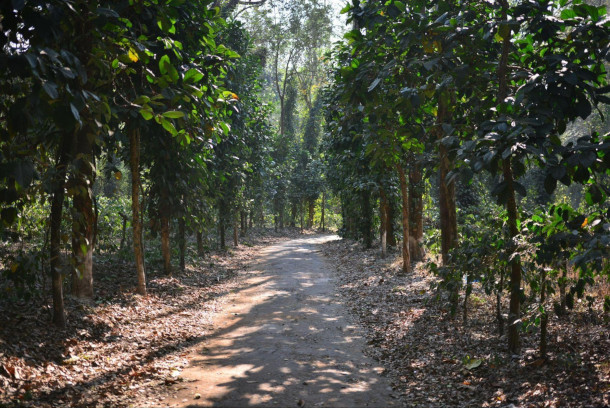
A walkway through the South India Coffee Company’s farm in Coorg, India. (Photo: South India Coffee Company)
PANDELIDIS: Interplanting can also promote nutrient recycling in exhausted soil and naturally restore land. So excelsa is not just climate-smart. It’s regenerative. Now India isn’t the only place where excelsa thrives. Pockets of Indonesia, Vietnam, Guinea, South Sudan, and Uganda are also producing it. Dr. Aaron Davis is keeping an eye on the crop’s international progress. He’s head of coffee research outside of London at The Royal Botanic Gardens Kew. He’s been working with Komal and other farmers across the world to conduct research on excelsa coffee and bring it to the global market. He says it’s still got a long way to go.
DAVIS: If you look at the amount of Excelsa coffee compared to Arabica and Robusta, it's a tiny, tiny percentage, like less than 1% so we're starting from a very, very small base, and it would take some years for it to start coming into the market in significant or substantial volumes.
PANDELIDIS: In the end, Dr. Davis believes climate change could force farmers towards excelsa.
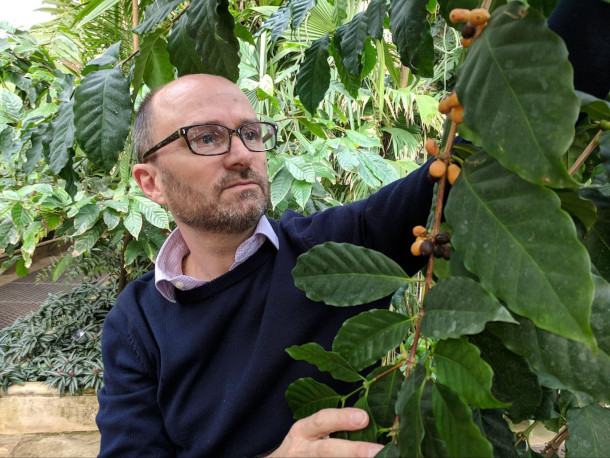
Dr. Aaron Davis is Senior Research Leader for Crops and Global Change at the UK Royal Botanic Gardens, Kew. (Photo: Courtesy of Jenny Williams, RBG Kew)
DAVIS: Sometimes we don't have a choice. I always say that its success will not really depend on the success of excelsa. It will depend on the failure of Arabic and Robusta.
PANDELIDIS: But consumers could also start preferring excelsa all on their own. So far, specialty roasters looking for a niche flavor profile are excelsa’s top customers. That might change as more people get a chance to taste test.
[SFX coffee grinding]
PANDELIDIS: I’ve ground some excelsa beans straight from Komal Sable’s farm in India. And to help out with sampling, I’ve asked my friend Alex who is a coffee connoisseur who orders different kinds of beans from around the world every month.
CAPOZZIELLO: It's got a very strong aroma to it. A mix of sweet, citrus and it's a tad bit nutty.
PANDELIDIS: Yeah, I think I smell the nutty more than the fruity. Maybe you just have a better nose than I do.
[SFX coffee pouring]
CAPOZZIELLO: Cheers!
PANDELIDIS: Cheers!
[SFX sipping]
CAPOZZIELLO: Hmm. It's definitely more sweet than a traditional coffee. It almost has a bourbon smell to it.
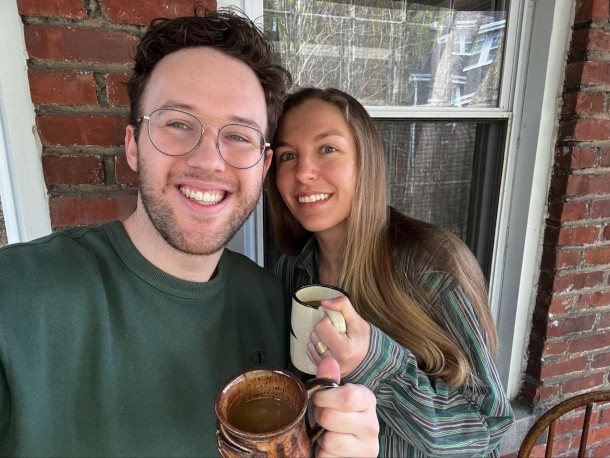
Living on Earth Producer Sophia Pandelidis and her “coffee connoisseur” friend, Alex Capozziello, test out excelsa coffee. (Photo: Alex Capozziello)
PANDELIDIS: Bourbon! I don't know if I can smell it, but I trust you. Honestly, I could maybe drink this black. I actually really like it, genuinely.
CAPOZZIELLO: I think if you're someone who enjoys a diner cup of coffee but wants to elevate it to have a more flavorful premiere taste without going super crazy, this could be a great coffee for you.
PANDELIDIS: I guess it’s official: excelsa is a winner. So maybe consumers will catch on, regardless of climate change. Back in India, Komal is preparing for excelsa’s future.
SABLE: We've been working with a lot of different farms as well, so we're looking at expanding to different plots of lands. People are definitely interested in planting more Excelsa.
PANDELIDIS: And it may not be long before you’re sipping it yourself.
[SFX coffee pouring]
PANDELIDIS: For Living on Earth, I’m Sophia Pandelidis.
Links
Living on Earth wants to hear from you!
Living on Earth
62 Calef Highway, Suite 212
Lee, NH 03861
Telephone: 617-287-4121
E-mail: comments@loe.org
Newsletter [Click here]
Donate to Living on Earth!
Living on Earth is an independent media program and relies entirely on contributions from listeners and institutions supporting public service. Please donate now to preserve an independent environmental voice.
NewsletterLiving on Earth offers a weekly delivery of the show's rundown to your mailbox. Sign up for our newsletter today!
 Sailors For The Sea: Be the change you want to sea.
Sailors For The Sea: Be the change you want to sea.
 The Grantham Foundation for the Protection of the Environment: Committed to protecting and improving the health of the global environment.
The Grantham Foundation for the Protection of the Environment: Committed to protecting and improving the health of the global environment.
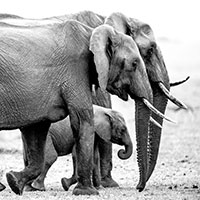 Contribute to Living on Earth and receive, as our gift to you, an archival print of one of Mark Seth Lender's extraordinary wildlife photographs. Follow the link to see Mark's current collection of photographs.
Contribute to Living on Earth and receive, as our gift to you, an archival print of one of Mark Seth Lender's extraordinary wildlife photographs. Follow the link to see Mark's current collection of photographs.
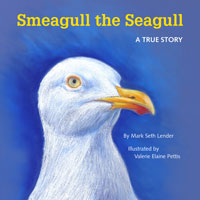 Buy a signed copy of Mark Seth Lender's book Smeagull the Seagull & support Living on Earth
Buy a signed copy of Mark Seth Lender's book Smeagull the Seagull & support Living on Earth

